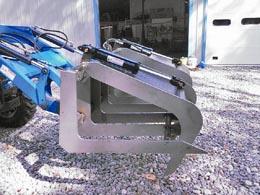 After he couldn't find what he wanted on the market, Tim Johnson, Howe, Ind., built a grapple fork for his New Holland 4060 tractor.
After he couldn't find what he wanted on the market, Tim Johnson, Howe, Ind., built a grapple fork for his New Holland 4060 tractor.
"I use it to clean up trees and brush around the edges of fields and to haul logs to our splitter. I'm amazed at how well it works," says Johnson, an engineer who also has a welding and machining background.
The quick-tach grapple fork measures 71 1/2 in. wide and is equipped with 40-in. long, 4-in. high tines at the bottom spaced 8 in. apart. The tines are made from 1/2-in. thick mild steel and are held together by a length of schedule 80 pipe. The 5-in. high upper tines are made from 5/8-in. thick steel.
A pair of 10-in. stroke hydraulic cylinders are used to raise and lower the shanks, which pivot up or down on a pair of 3/4-in. steel pins. A quick-tach plate is welded on back of the frame.
"It's big enough to pick up large quantities of brush and wood, yet is lightweight enough for my 60 hp tractor," says Johnson. "The shanks open up about 4 ft. high, which is big enough to pick up large quantities of brush and wood. It'll handle logs up to 32 in. in dia.
"I needed a grapple fork with long bottom tines that I can slide under large piles of tree limbs and pick them up. However, the bottom tines on most factory-built grapple forks are only about 24 in. long and have about 22 in. of usable space. They work good for picking up logs, but when you clamp down on a pile of brush you don't get very much. In comparison, the 40-in. long bottom tines on my grapple fork have 34 in. of usable space.
"I spent about $900 to build it, which compares to $2,500 to $3,500 for comparable commercial grapple forks."
Contact: FARM SHOW Followup, Tim Johnson, 4925N 900E, Howe, Ind. 46746 (ph 260 350-1057; flagvan2000@yahoo.com).
1-800-834-9665
"Made It Myself" Heavy-Duty Brush Grapple Fork
FARM SHOW Magazine » "Made It Myself" Heavy-Duty Brush Grapple Fork
"Made It Myself" Heavy-Duty Brush Grapple Fork
